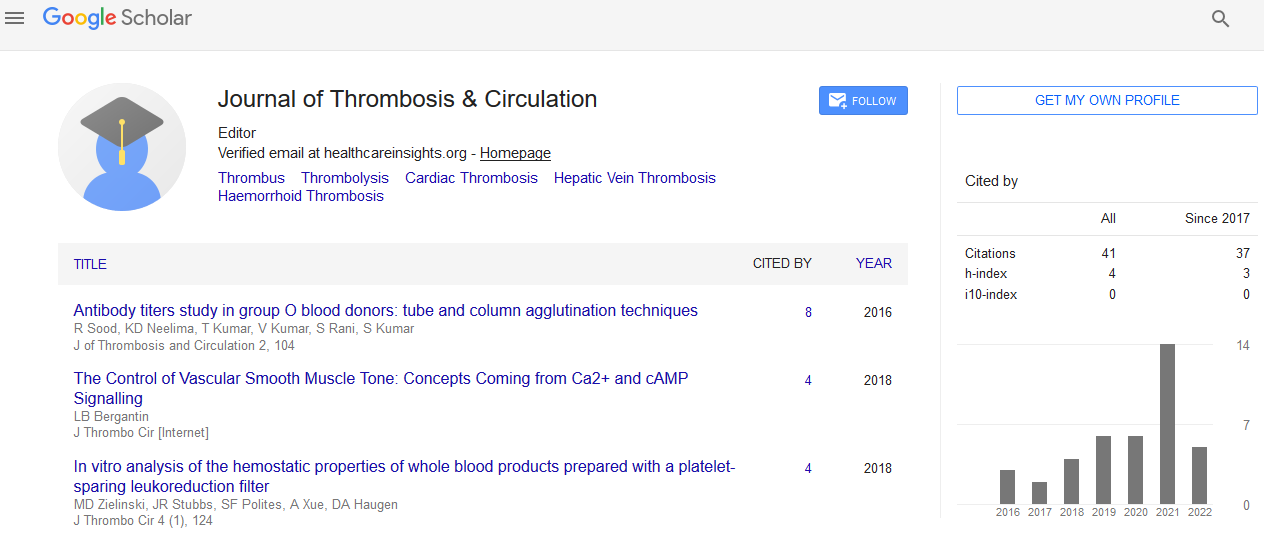Indexed In
- RefSeek
- Hamdard University
- EBSCO A-Z
- Publons
- Google Scholar
Useful Links
Share This Page
Journal Flyer

Open Access Journals
- Agri and Aquaculture
- Biochemistry
- Bioinformatics & Systems Biology
- Business & Management
- Chemistry
- Clinical Sciences
- Engineering
- Food & Nutrition
- General Science
- Genetics & Molecular Biology
- Immunology & Microbiology
- Medical Sciences
- Neuroscience & Psychology
- Nursing & Health Care
- Pharmaceutical Sciences
Short Article - (2021) Volume 7, Issue 2
Hypercoagulability: Systematic View
Mani Chandan Katthula*Received: 05-Mar-2021 Published: 26-Mar-2021, DOI: 10.35248/2572-9462.21.7.152
Abstract
Hypercoagulability or thrombophilia is the expanded propensity of blood to thrombose. An ordinary and solid reaction to seeping for keeping up hemostasis includes the development of a steady coagulation, and the interaction is called coagulation. Hypercoagulability depicts the pathologic condition of overstated coagulation or coagulation without dying. Various constituents of the blood interface to make a clots. Diverse hypercoagulable states and thrombophilic sicknesses cause hypercoagulability.Introduction
Hypercoagulability or thrombophilia is the expanded propensity of blood to thrombose. An ordinary and solid reaction to seeping for keeping up hemostasis includes the development of a steady coagulation, and the interaction is called coagulation. Hypercoagulability depicts the pathologic condition of overstated coagulation or coagulation without dying. Various constituents of the blood interface to make a clots. Diverse hypercoagulable states and thrombophilic sicknesses cause hypercoagulability.
ETIOLOGY
Hypercoagulability issues are either gained or acquired. Nonetheless, real apoplexy happens because of the interchange of both hereditary and ecological factors and follows the various hit theory. This two thrombophilia’s ensnare a powerless thrombotic hazard. Obtained factors additionally impact the coagulation course and incorporate a medical procedure, pregnancy, hormonal substitution treatment, contraception, threat, irritation, disease, and heparin-incited thrombocytopenia [1].
The STUDY of DISEASE TRANSMISSION
Venous thromboembolism is the second most normal cardiovascular issue following myocardial localized necrosis; it is more incessant than stroke. . Its frequency ranges somewhere in the range of 1 and 5 out of 1000 every year in everyone. The recurrence of thrombophilias with APS, APC opposition, raised factor VIII as 25 to 28%; protein C lack, protein S inadequacy, hyperhomocysteinemia and prothrombin transformation as 5 to 10%.
PATHOPHYSIOLOGY
Coagulation is an innate property of the hematologic framework and under sound conditions, ordinary blood stream is kept up by the harmony between the favorable to coagulant and against thrombotic factors.A hypercoagulable state and ensuing thromboembolism is a consequence of overactivity of supportive of coagulant factors or a inadequacy in enemies of coagulants. The transaction of elements is confounded - coagulation activators and inhibitors and their creation and corruption (quantitative) and practical properties (subjective) all impact apoplexy. Changes impact coagulation relying upon whether they are available in heterozygous or homozygous genotype [2].Some Coagulation Disorders incorporate Antithrombin III (ATIII) inadequacy. Antithrombin III ties to heparin on endothelial cells and structures a complex with (thrombinantithrombin (TAT) complex) hence restraining coagulation. Its inadequacy may present as early age apoplexy. also, conveys the most elevated danger for thrombotic occasions among the acquired thrombophilia’s. Antithrombin is blended in the liver yet isn't nutrient K-subordinate. ATIII inadequacy can happen as a result of diminished union (liver harm) or expanded misfortune (nephrotic disorder, enteropathy, DIC, sepsis, consume, injury, microangiopathy, and cardiopulmonary detour a medical procedure). Protein C insufficiency can present as apoplexy in young people. Protein C and S lack might be acquired but at the same time is inducable by liver brokenness, nutrient k foes, renal disappointment, DIC, and dynamic apoplexy. Protein S improves the impact of enacted protein C. T- lymphocytes (Tcells). Protein C associates with thrombomodulin to become enacted protein C (APC). Initiated protein C inactivates coagulation factors V and VIII. The factor V Leiden transformation is a typical reason for APC opposition and the most regular hereditary thrombophilia. Prothrombin is the forerunner of thrombin, which is factor II. The prothrombin G20210A change is the second most basic acquired danger factor for apoplexy and prompts expanded degrees of prothrombin which exhibits a higher danger for blood vessel and venous thrombotic occasions.Hyperhomocysteinemia is related with untimely atherosclerosis and apoplexy and brought about by imperfections of the methionine metabolic pathway Hyperhomocysteinemia is related with untimely atherosclerosis and apoplexy and brought about by imperfections of the methionine metabolic pathway.Hyperhomocysteinemia is related with untimely atherosclerosis and apoplexy and brought about by imperfections of the methionine metabolic pathway. Dysfibrinolysis incorporates plasminogen inadequacy, dysfibrinogenemia, tissue plasminogen activator (tPA) insufficiency, plasminogen activator inhibitor (PAI) increment, and factor XII lack, which is associated with plasmin age. Dysfibrinolysis incorporates plasminogen inadequacy, dysfibrinogenemia, tissue plasminogen activator (tPA) insufficiency, plasminogen activator inhibitor (PAI) increment, and factor XII lack, which is associated with plasmin age. The tacky platelet condition is an autosomal prevailing illness wherein platelets coming into contact with epinephrine or adenosine diphosphate (ADP) respond to initiate hypercoagulability. Harm is the second most regular gained hypercoagulability and prompts a prothrombotic state through the creation of procoagulant factors (tissue factor and disease procoagulant) and the association of tumor cells with blood and vascular endothelium. Rare conditions joined by HE are acquired immunodeficiency’s, like Omenn disorder [3] .
TREATMENT/MANAGEMENT
The replacement of coagulation components can accomplish causal treatment. New frozen plasma (FFP) contains the characteristic equilibrium of procoagulant and anticoagulant factors. Instruments to assess the individual danger of apoplexy incorporate various scores, for example, HERDOO, VIENNA, and DASH and the diverse thrombotic capability of thrombophilias (solid versus feeble thrombophilias) needs thought.
REFERENCES
- Prandoni P. Venous and arterial thrombosis: Two aspects of the same disease? Clin Epidemiol. 2009 Aug 09;1:1-6.
- Previtali E, Bucciarelli P, Passamonti SM, Martinelli I. Risk factors for venous and arterial thrombosis. Blood Transfus. 2011;9(2):120-138.
- Egeberg o. inherited antithrombin deficiency causing thrombophilia. Thromb Diath Haemorrh. 1965 ;13:516-530

